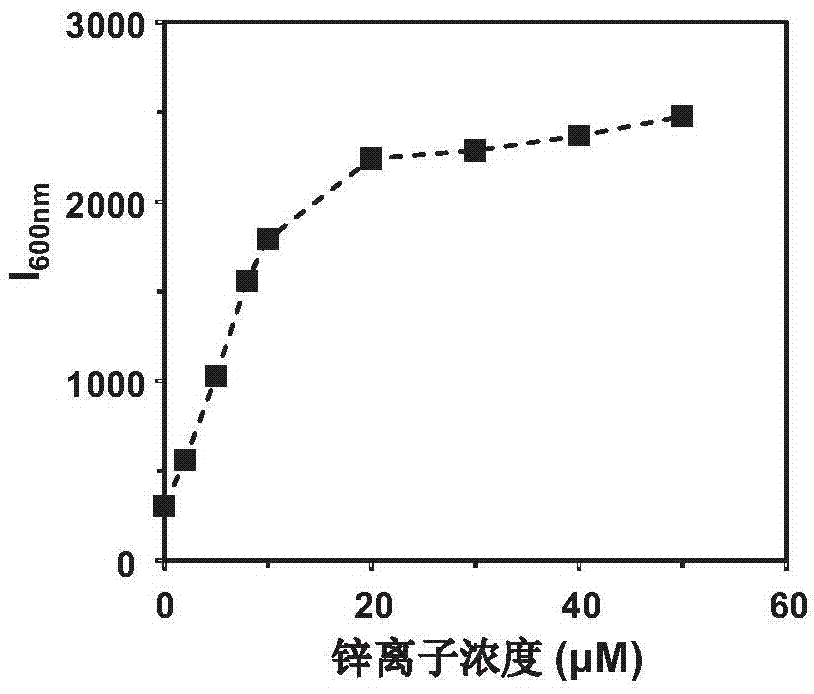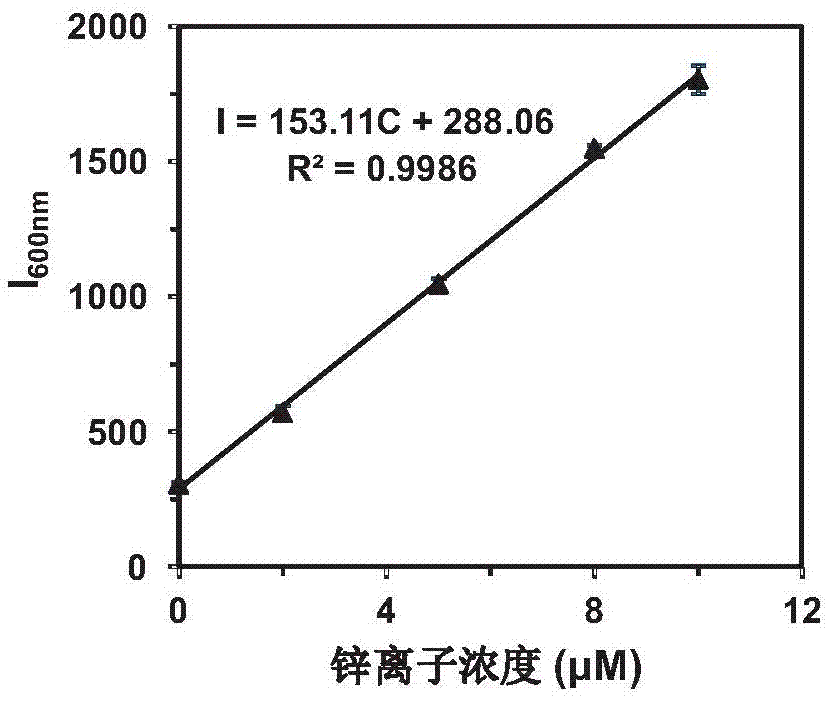Zinc ion detection method
A detection method and zinc ion technology, applied in the field of nano-fluorescent probes, can solve the problems of complicated probe synthesis steps and complex mechanism, and achieve the effects of good application prospect, good selectivity and simple method.
- Summary
- Abstract
- Description
- Claims
- Application Information
AI Technical Summary
Problems solved by technology
Method used
Image
Examples
Embodiment 1
[0028] This embodiment includes the following steps:
[0029] 1. Preparation of self-assembled nanoparticles: inject 50 μL of BODIPY small molecule solution with a concentration of 0.1 mM dissolved in DMF into 0.95 mL of HEPES buffer solution with a concentration of 5 mM and pH=7.4, and mix well to obtain self-assembled nanoparticles. Particles, spare.
[0030] 2. Draw a standard curve: take 150 μL of the solution obtained in step 1, and add 1.5 μL of zinc ion standard solutions of different concentrations, so that the concentrations of zinc ions in the mixed solution are 2, 5, 8, 10, 20, 30, 40, 50μM, after incubation for 10min, reserved for determination. Take another 150 μL of the solution obtained in step 1, and add 1.5 μL of deionized water as the blank control system solution. Place the standard solution and the blank control solution in a fluorescence cuvette with an optical path of 1 cm, scan the emission spectrum, and obtain the fluorescence spectrum, such as figur...
Embodiment 2
[0036] 1. Determination of zinc ions in human hair samples: collect human hair samples, wash them once with shampoo, wash them with deionized water for 10 times, then immerse them in acetone solution for 2 hours, then wash them with deionized water for 10 times. Dry in an oven at 80°C until constant weight, cut into hair sections less than 1cm with stainless steel scissors, and store in a desiccator. Weigh 9.84g of hair into a microwave digestion tank, add 8mL of 65% nitric acid and 1mL of 30% hydrogen peroxide, leave it at room temperature for 10h, install the digestion tank on the microwave digestion instrument, follow the program "130℃, 10min; 150℃ , 5min; 180°C, 40min" was digested at 480W power, the liquid obtained after digestion was transferred to a 50mL beaker, heated on an electric stove until the liquid just evaporated to dryness, and 1mL deionized water was added to the beaker. Shake in the container for 2 minutes, add 9 mL of HEPES buffer solution with a concentrat...
PUM
 Login to View More
Login to View More Abstract
Description
Claims
Application Information
 Login to View More
Login to View More - R&D
- Intellectual Property
- Life Sciences
- Materials
- Tech Scout
- Unparalleled Data Quality
- Higher Quality Content
- 60% Fewer Hallucinations
Browse by: Latest US Patents, China's latest patents, Technical Efficacy Thesaurus, Application Domain, Technology Topic, Popular Technical Reports.
© 2025 PatSnap. All rights reserved.Legal|Privacy policy|Modern Slavery Act Transparency Statement|Sitemap|About US| Contact US: help@patsnap.com



